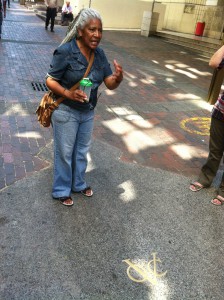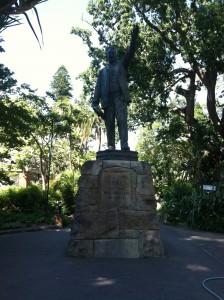“In the light of memory and remembering * Through the streams of our senses * Reconnecting * Recollecting * We find our way home”
Ty Campbell ’16 – The above quote is a shortened version of Malika Ndlovu’s poem “Slave Dreams.” The summarized lines are also

located on the Column of Memory exhibit, found at the Iziko Slave Lodge museum in Cape Town. Lucy Campbell, one of our tour guides of the day, worked on the research into the exhibit while being hired by the museum. The Column of Memory illuminates a column of the original names of slaves who were brought to South Africa starting during the late 17th century. Campbell explained that the Dutch East India Company, when first colonizing the contemporary country of South Africa, needed slaves as labor to begin building the city. Several individuals were brought to Cape Town from West Africa, East Africa, India, Sri Lanka (Ceylon), and the Indonesian Archipelago to serve as human slaves in the project to erect the city. Khoi and San people were the original inhabitants of Cape Town. Once known as the slave capitol of the world, Cape Town built the Slave Lodge in 1679 and housed hundreds of humans at a time. According to Campbell, Boer (Dutch) Cape Town colonizers wished to keep good relationships with the aboriginal inhabitants by using imported slaves to build various structures rather than imprisoning the Khoi and San. The Lodge was referred to as “a warehouse of human misery” and those imprisoned within the walls suffered harsh treatment and care. Before the inclusion of the museum’s exhibit, rarely were the individuals who created Cape Town recognized for their efforts. Without the recognition of others, the city’s history of achievement through brutality could be lost in history. Campbell’s overarching message to our group is that Cape Town is a symbol of colonization. One of the points of interest we saw along our walking tour included a symbol of the oppressing force of the Dutch East India Company. On one of the busy streets of the Cape Town, a large and looming symbol of the colonizers is still paved into the street. The gold letters ‘VOC,’ standing for Vereenigde Oost-Indische Compagnie (the Dutch East India Company), are currently still placed in the city to be recognized by the thousands of people who walk the

street each day. Other oppressive figures, like the statue of Cecil John Rhodes in a local park, still stand in a city within Cape Town. Campbell uses the term ‘mental slavery’ as an interchangeable term that our class has used as the ‘oppressed mind.’ This term refers to the idea that the colonized and oppressed develop a type of mental strain that effect those negatively viewed. Though our contemporary view of ignorance to Cape Town’s past, many people let the prejudice and factors that further the idea of the mental slavery that

still exists in Cape Town continue. Meeting with Campbell has presented our class with a perspective that a textbook cannot. “Decolonization is much more than academia. A large part of recovery has to first start with attitude. This even includes the way we look at and view others,” Campbell said. To some, Cape Town’s beautiful landscapes may serve as camouflage of the history of the past. Although the city has been built upon the culture and past of others, we must not forget the past and struggles of others to build an equal and accommodating home for all under the ‘Rainbow Nation.’ Like the opening quote suggests, the power of remembering, reconnecting, and recollecting will help shape the country and city’s future through it’s own past.